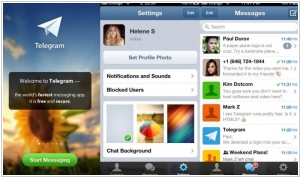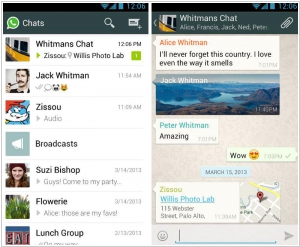Telegram vs WhatsApp
March 15, 2025 | Author: Adam Levine
16★
Telegram is a messaging app with a focus on speed and security. It’s super-fast, simple, secure and free. Telegram seamlessly syncs across all of your devices and can be used on desktops, tablets and phones alike. You can send an unlimited amount of messages, photos, videos and files of any type (.doc, .zip, .pdf, etc.). Telegram groups have up to 200 people and you can send broadcasts to up to 100 contacts at a time. Be sure to check our website for a list of Telegram apps for all platforms.
27★
WhatsApp Messenger is a cross-platform mobile messaging app which allows you to exchange messages without having to pay for SMS. WhatsApp Messenger is available for iPhone, BlackBerry, Android, Windows Phone and Nokia and yes, those phones can all message each other! Because WhatsApp Messenger uses the same internet data plan that you use for email and web browsing, there is no cost to message and stay in touch with your friends.
Telegram and WhatsApp are remarkably similar in a way that makes you wonder if they’re not secretly distant cousins who only meet at family reunions. Both let you message people in an instant, share images, videos and documents, and, in theory, keep your conversations private with a touch of end-to-end encryption. They’re both multi-platform marvels, and, just to make sure no one feels left out, they even allow group chats with a variety of people—though how many people might depend on which one you’re using.
Telegram, on the other hand, is like the eccentric relative who shows up with ideas that no one else has quite thought of yet. It was born in 2013 in Russia, not exactly the birthplace of casual messaging, but it quickly turned cloud-based, making sure your chats float serenely across all your devices. Groups? Oh, they’re big—up to 200,000 people, which might be ideal for your next impromptu global summit. Telegram also gives you channels, for when you need to broadcast your thoughts to the world and everything is open-source, meaning you can tinker with it as much as you like. Also, they’ve got bots and not the boring kind—the useful, creative kind.
WhatsApp, however, is a bit more down-to-earth and seems to prefer keeping things a bit more cozy. Born in 2009 in the United States, it quickly became the app for keeping in touch with friends and family, with a focus on simplicity over cloud-based sorcery. Groups on WhatsApp can hold a modest 256 people, which, frankly, is plenty unless you’re trying to start a global revolution. Unlike Telegram, it doesn’t do channels and is still tightly attached to Meta, which is an important detail if you’re into things like privacy (or, perhaps, the lack thereof). So, while both are great at messaging, each app has its own quirks that make it distinctly… well, itself.
See also: Top 10 Business Messaging platforms
Telegram, on the other hand, is like the eccentric relative who shows up with ideas that no one else has quite thought of yet. It was born in 2013 in Russia, not exactly the birthplace of casual messaging, but it quickly turned cloud-based, making sure your chats float serenely across all your devices. Groups? Oh, they’re big—up to 200,000 people, which might be ideal for your next impromptu global summit. Telegram also gives you channels, for when you need to broadcast your thoughts to the world and everything is open-source, meaning you can tinker with it as much as you like. Also, they’ve got bots and not the boring kind—the useful, creative kind.
WhatsApp, however, is a bit more down-to-earth and seems to prefer keeping things a bit more cozy. Born in 2009 in the United States, it quickly became the app for keeping in touch with friends and family, with a focus on simplicity over cloud-based sorcery. Groups on WhatsApp can hold a modest 256 people, which, frankly, is plenty unless you’re trying to start a global revolution. Unlike Telegram, it doesn’t do channels and is still tightly attached to Meta, which is an important detail if you’re into things like privacy (or, perhaps, the lack thereof). So, while both are great at messaging, each app has its own quirks that make it distinctly… well, itself.
See also: Top 10 Business Messaging platforms





